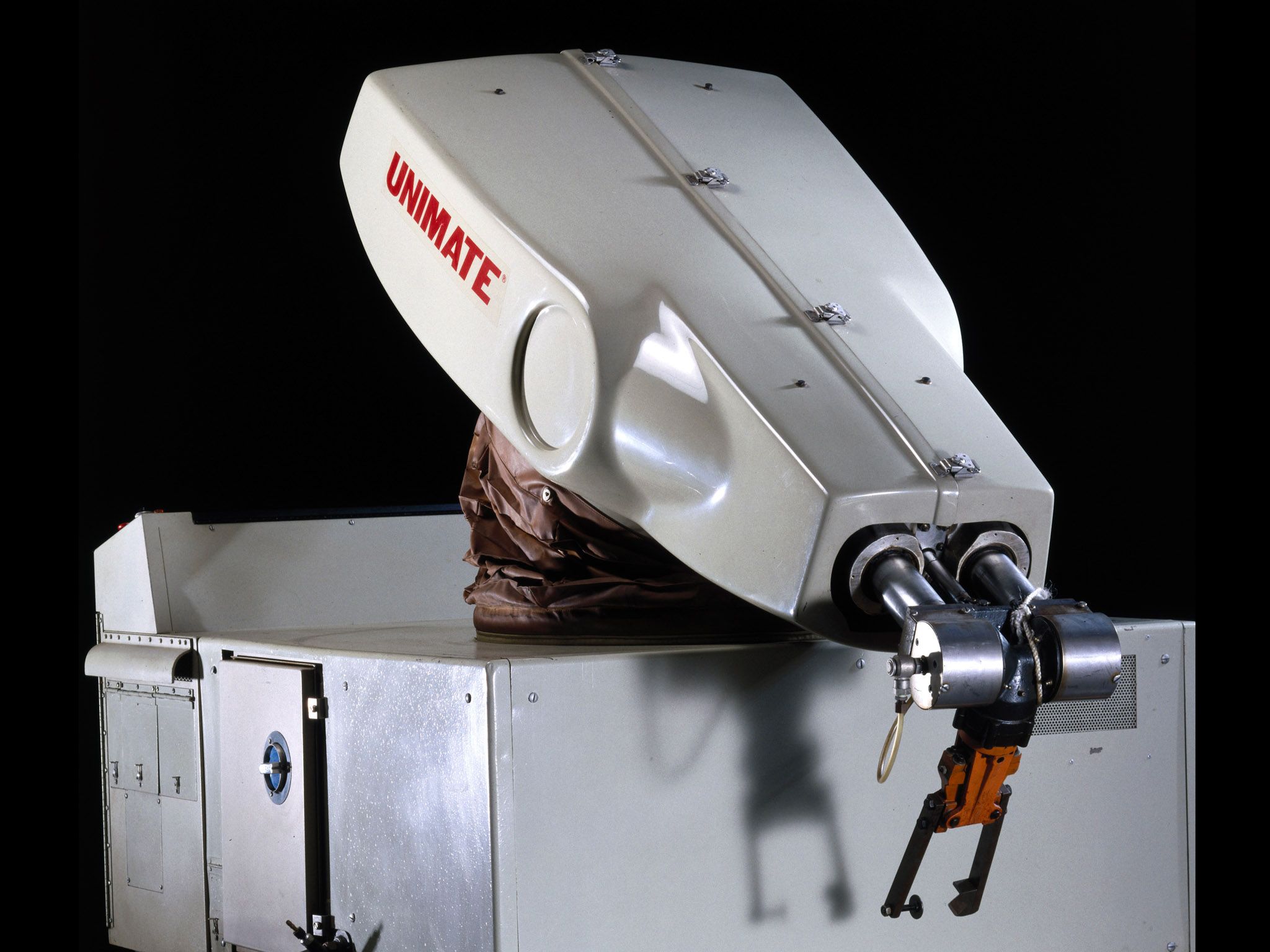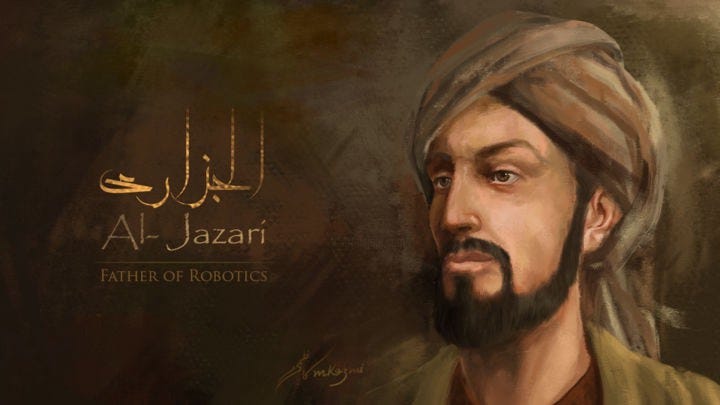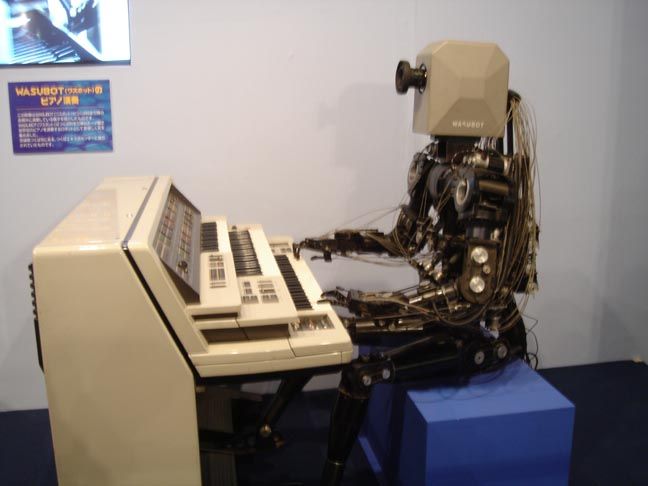Born of The First Industrial Robot: Unimate!
October 25th, 2023 by RAS Chapter

Imagine yourself working in a big car factory where you have to arrange the same car parts every day. This work is exhausting and boring, right? But what if someone gave you a robot friend to help you? That’s what happened in the 1960s at General Motors, where the first industrial robot was born, called Unimate.
Unimate Robot is the first successful application of an industrial robot. It was a large, industrial robot arm with six axes of motion, capable of lifting heavy objects and moving them precisely in 3D space. Unimat controlled by a magnetic drum and a computer. It received data about the environment and position of Unimate from its sensors. A programming language called VAL was used in this robot, which allowed the user to specify the arm’s position and movement, the timing and sequence of operations, and safety checks to protect the machine and its human operators.
Unimate was used for a variety of tasks, including die casting, welding, and material handling. It was also used in the food industry, where it was used to package and palletize products.
This robot was created by George Devol and Joseph Engelberger in the early 1960s. Together, they designed the robot and developed the necessary software and control systems.
Unimate was a relatively simple robot by today’s standards, but it was a revolutionary machine in its time. It helped to improve productivity and safety in the workplace and laid the foundation for the modern robotics industry.
في مصنع السيارات الكبير، حيث يتعين عليك ترتيب ننفس أجزاء السيارات يوماً بعد يوم، هذا العمل مرهق وممل، أليس كذلك؟ ولكن ماذا لو أعطاك شخص ما صديقًا روبوتًا لمساعدتك؟ هذا ما حدث في الستينيات في شركة جنرال موتورز، حيث ولد أول روبوت صناعي يسمى Unimate.
يُعتبر يونيميت الخطوة الأولى الناجحة في تطبيقات الروبوتات الصناعية. كان ذراعًا صناعيًا كبيرًا مزوّدًا بستة محاور حركة، قادرًا على رفع الأشياء الثقيلة وتحريكها بدقة في الفضاء ثلاثي الأبعاد، تم التحكم في Unimate بواسطة أسطوانة مغناطيسية وجهاز كمبيوتر يتلقيان بيانات حول البيئة وموقع Unimate من أجهزة الاستشعار الخاصة به. تم استخدام لغة برمجة تسمى VAL في هذا الروبوت، مما يسمح للمستخدم بتحديد موقع الذراع وحركته، وتوقيت وتسلسل العمليات، وشملت عمليات التحقق من السلامة لحماية الجهاز والعاملين على تشغيله من أي خطر .
تم استخدام Unimate لمجموعة متنوعة من المهام، بما في ذلك الصب في القوالب واللحام ومعالجة المواد. تم استخدامه أيضًا في صناعة الأغذية، حيث تم استخدامه لتعبئة المنتجات وتغليفها.
تم إنشاء هذا الروبوت بواسطة جورج ديفول وجوزيف إنجل بيرجر في أوائل الستينيات. قاما معًا بتصميم الروبوت وتطوير البرامج وأنظمة التحكم اللازمة.
كان Unimate روبوتًا بسيطًا نسبيًا وفقًا لمعايير اليوم، لكنه كان آلة ثورية في عصره. ساعد في تحسين الإنتاجية والسلامة في مكان العمل ووضع الأساس لصناعة الروبوتات الحديثة.
About
RAS HISTORY Deep diving into ancient robots, tracing the evolution of robotics and automation systems from their earliest incarnations. Uncovering the stories of pioneers, witnessing the birth of the first robots.
An Older Japanese’s Robots!
October 10th, 2023 by RAS Chapter

In this series, we will talk about older Japanese robots. Kara puppets are traditional Japanese mechanized puppets, or automata, made from the 17th century to the 19th century. The name karakuri is thought to come from the Japanese verb karakuru, which means “to pull, stretch, and move a thread”. The gears and cams used in clock-making were used to create it.
There are three main types of Karakuri :
1. Butai Karakuri: It is life-sized dolls designed for public performances such as in theaters.
2. Dashi Karakuri: large mechanical floats used in religious festivals, where puppets were used for the re-enactment of traditional myths.
3. Zashiki Karakuri: Most of them were set on a table and performed a dance or beat drums, but some were designed to serve tea .
The most popular example of the Zashiki Karakuri mechanism is the one designed to serve tea , which starts moving forward when a cup of tea is placed on the plate in its hands. It moves in a straight line for a set distance, moving its feet as if walking, and then bows its head. The doll stops when the cup is removed. When it is replaced, the robot raises its head, turns around, and returns to where it came from. It is typically powered by a wound spring , and the actions are controlled by a set of cams and levers.
In conclusion, I hope you will delve deeper into the study of these robots, as they represent a profoundly intricate and captivating realm of mechanical engineering.
في هذه السلسلة سنتحدث عن روبوتات يابانية قديمة. روبوتات كاراكوري وهي دمى آلية تقليدية، صُنعت في الفترة من القرن السابع عشر إلى القرن التاسع عشر تسمى دمى كاراكوري. يُعتقد أن اسم كاراكوري مشتق من الفعل الياباني “كاراكورا” والذي يعني سحب الخيط ،تمديده وتحريكه.
هناك ثلاثة أنواع رئيسية من دمى كاراكوري :
- دمى كاراكوري المسرحية ( Butai Karakuri ) : وهي دمى بحجم الإنسان مصممة للعروض العامة مثل المسارح.
- دمى كاراكوري الاحتفالية ( Dashi Karakuri ) : وهي عوامات آلية كبيرة تُستخدم في المهرجانات الدينية، حيث تُستخدم الدمى لإعادة تمثيل الأساطير التقليدية.
- دمى كاراكوري المنزلية (Zashiki Karakuri) : وهي دمى صغيرة تُستخدم في المنزل. معظمها كانت تُوضع على طاولة وتؤدي رقصة أو تضرب الطبول، ولكن بعضها كان مصمماً لتقديم الشاي.
أشهر مثال على دمى كاراكوري المنزلية هو الدمية المصممة لتقديم الشاي، والتي تبدأ في التحرك للأمام عند وضع كوب من الشاي على الصحن في يديها. ثم تتحرك في خط مستقيم لمسافة محددة، وتحرك قدميها وكأنها تمشي، ويكون رأسها منحني للأسفل،و تتوقف الدمية عند إزالة الكوب. وعند إعادة وضعه، ترفع الدمية رأسها وتستدير وتعود إلى حيث أتت. تعمل الدمية عادةً بنابض لولبي، يتم التحكم في أفعاله من خلال مجموعة من الكُمّات والروافع.
في الختام، آمل أن تتعمقوا أكثر في دراسة هذه الروبوتات، لأنها تمثل عالمًا معقدًا وآسرًا للهندسة الميكانيكية.
About
RAS HISTORY Deep diving into ancient robots, tracing the evolution of robotics and automation systems from their earliest incarnations. Uncovering the stories of pioneers, witnessing the birth of the first robots.
It is Not True!
April 9th, 2023 by RAS Chapter

Many of us believe that the first to invent the idea of “robot” is the Western world and that is not true. Who is the first inventor of robotics and mechanical machines?
We are back with a new topic from the RAS History series, and it is: Ismail Al-Jazari.
Badie Al-Zaman Abu Al-Ezz bin Ismail bin Al-Razzaz Al-Jazari, A Muslim scholar born in 1136 AD on an island that was called “Abu Omar”, from which his nickname “Al-Jazari” came.
What is curious about this person is that he was the first to make a moving human or “robot”. At the request of the Emir of “Diyarbakir” called “Amed” to make a machine that would dispense him the need for servants whenever he wanted to perform ablution for prayer.
So the carrot made a machine in the form of a boy, erect in stature, in his hand a water jug and in the other hand a towel, in addition to the presence of a bird on the boy’s turban, where it whistles whenever it’s time to pray, then this boy or servant advances to his master “Amad” to pour water for him in a certain amount, and when he finishes ablution, he offers him the towel and returns to his place.
Among the most prominent inventions of “Al-Jazari” are water-powered self-propelled instruments, measuring instruments, musical instruments, water clocks with a self-alert system, and an elephant clock in which several parts and instruments were collected that represented the civilizations and cultures they lived with, and now it is called the “United Nations Clock”.
His book “The Whole of Science and Beneficial Work in the Making of Tricks” is one of his most prominent books, which he spent about 25 years writing. This book was the primary reference for medieval mechanical and hydraulic machines, and its most prominent feature was the presence of drawings and designs of these machines, and it was translated into many languages.
Al-Jazari was one of the pillars of the Islamic scientific renaissance, which formed the basis of later Western scientific civilization.
كثيرٌ منا يعتقد أن أول من ابتكر فكرة “الروبوت” هو العالم الغربي وذلك غير صحيح. فمن هو المخترع الأول للروبوتات والآلات الميكانيكية؟
عدنا معكم بموضوع جديد من سلسلة Ras History وهو: إسماعيل الجزري .
بديع الزمان أبو العز بن إسماعيل بن الرزاز الجزري، عالم مسلم ولد عام 1136 ميلادية في جزيرة كانت تُسمى “أبو عمر”، ومنها جاء لقبه “الجزري”.
ما يُثيرُ الفضول في هذا الشخص أنه كان أول من صنع الإنسان المتحرك أو “الروبوت”. بناءاً على طلب أمير “ديار بكر” ويُدعى “آمِد” أن يصنع آلةً تغنيه عن الخدم كلما رغِب في الوضوء للصلاة.
فصنع الجزري آلة على هيئة غلام، منتصب القامة، وفي يده إبريق ماء وفي اليد الأخرى منشفة، بالإضافة إلى وجود طائر على عمامة الغلام، حيث يصفّر كلما حان وقت الصلاة، ثم يتقدم هذا الغلام أو الخادم إلى سيده “آمِد” ليصبّ الماء له بمقدارٍ معين، وعند انتهائه من الوضوء يقدم له المنشفة ويعود إلى مكانه.
ومن أبرز اختراعات “الجزري” الآلات الذاتية الحركة التي تعمل بالماء، آلات القياس، الآلات الموسيقية، ساعات مائية ذات نظام تنبيه ذاتي، وساعة الفيل التي جمع فيها عدة أجزاء وأدوات مثلت الحضارات والثقافات التي عاصرها، والآن يطلق عليها اسم “ساعة الأمم المتحدة”.
ويُعد كتابه “الجامع بين العلم والعمل النافع في صناعة الحيل” من أبرز كتبه الذي أمضى حوالى 25 عاماً في كتابته. كان هذا الكتاب المرجع الأساسي للآلات الميكانيكية والهيدروليكية في القرون الوسطى، وأبرز ما كان يميزه هو وجود رسوم وتصاميم لهذه الآلات، وتمت ترجمته للكثير من اللغات.
كان يُعد “الجزري” أحد أعمدة النهضة العلمية الإسلامية، التي شكلت أساساً للحضارة العلمية الغربية فيما بعد.
About
RAS HISTORY Deep diving into ancient robots, tracing the evolution of robotics and automation systems from their earliest incarnations. Uncovering the stories of pioneers, witnessing the birth of the first robots.
Old Robot Can Play Music!
March 19th, 2023 by RAS Chapter

Have you ever heard of something like this? We are back with a new topic from RAS HISTORY series, and it is: Wabot 2.
We’re back with you with a new topic from the RAS History Series. We will talk about: Father of Robotics.
Wabot 2, A robot who can read notes and play the electronic keyboard, has a head camera and hands five fingers capable of performing accurate and sensitive movements like a human.
This robot was invented by the Japanese University of Waseda, and the university was keen to make a smart robot capable of using the keyboard effectively as well as playing and reading musical notes that the robot can read through cameras installed in its head.
He can play very difficult tones and talk to people in Japanese, listen to singers, and adjust his pace to demand.
Wabot2, has several features that distinguish it from other robots: a camera, skilled hands, speakers, and microphones, it has 80 microprocessors.
Wabot 2, is an updated second version, where Waseda University made the first version of Wabot 1 but with fewer features, and then a new version was developed and released.
Wabot 1, was able to measure the distance and direction of the objects it was looking for, all thanks to its external receptors, ears, eyes, and artificial mouth containing sensors that are also present in the second version of Wabot.
This shows us the world’s interest in robots and their development since ancient times, and this confirms their importance, but some see them as not fulfilling the purpose, as human skills cannot be dispensed with and replaced by a robot.
And you, what do you think? Share your feedback with us and always be on time.
عدنا معكم بموضوع جديد من سلسلة RAS HISTORY سنتحدث اليوم عن :Father of Robotics
أُطلق لقب father of Robotics على جوزيف إنغلبرغر وهو عالم فيزياء ومهندس ورجل أعمال أمريكي، قام جوزيف بتطوير أول روبوت صناعي في الولايات المتحدة واسمه “Unimate” والذي أسهم بشكل كبير في صناعة السيارات مع شركة فورد .
عمل في الخمسينات من القرن الماضي كرجل أعمال ومدافع قوي عن تكنولوجيا الروبوتات في عدة مجالات. كان جوزيف مهتماً كثيراً بشأن علم الروبوتات واستخدامها لصالح البشرية، حيث أنه وسع أبحاثه الى قطاع متخصص اسمه”روبوتات الخدمة” ومن ثم أسس شركة خاصة يمكن من خلالها استخدام الروبوتات في أماكن الرعاية الطبية لاسيما في خدمة المسنين، كما وأنه ألف منشور بعنوان “التأثير الاقتصادي والاجتماعي للروبوتات الصناعية”.
حصل جوزيف على عدد كبير من الجوائز بما في ذلك درجات الدكتوراة، كما وأنه حصل على درجة الماجستير في العلوم في الهندسة الميكانيكية من جامع كولومبيا لتصميم أنظمة التحكم لمحطات الطاقة النووية
يعد جوزيف إنغلبرغر شخص ملهم جداً في عالم الروبوتات ويستحق تسليط الضوء عليه، كما وأنه أحد أهم العلماء والمهندسين الذي كان لهم دوراً كبيراً في تطور الروبوتات.
كونوا دائماً على الموعد وانتظرونا بكل ما هو جديد في عالم الروبوتات والأتمتة.
About
RAS HISTORY Deep diving into ancient robots, tracing the evolution of robotics and automation systems from their earliest incarnations. Uncovering the stories of pioneers, witnessing the birth of the first robots.
Who is The Father of Robotics?
March 1st, 2023 by RAS Chapter

We’re back with you with a new topic from the RAS History Series. We will talk about: Father of Robotics.
Named father of Robotics, Joseph Engelberger, an American physicist, engineer, and entrepreneur, developed the first industrial robot in the United States called “Unimate,” which contributed significantly to the automotive industry with Ford.
In the 1950s, he worked as a businessman and a strong advocate for robotics technology in several fields. Joseph was very interested in robotics and its use for the benefit of humanity, as he expanded his research to a specialized sector called “service robots” and then founded a private company through which robots can be used in medical care settings, especially in the service of the elderly, and he also wrote publications entitled “The Economic and Social Impact of Industrial Robotics”.
Joseph has received a large number of awards including Ph.D. degrees, he also earned a Master of Science degree in Mechanical Engineering from Columbia University to design control systems for nuclear power plants.
Joseph Engelberger is a very inspiring person in the world of robotics. He deserves to be highlighted, and he is also one of the most important scientists and engineers who played a major role in the development of robots.
Always be on time and wait for us with everything new in the world of robotics and automation.
عدنا معكم بموضوع جديد من سلسلة RAS HISTORY سنتحدث اليوم عن :Father of Robotics
أُطلق لقب father of Robotics على جوزيف إنغلبرغر وهو عالم فيزياء ومهندس ورجل أعمال أمريكي، قام جوزيف بتطوير أول روبوت صناعي في الولايات المتحدة واسمه “Unimate” والذي أسهم بشكل كبير في صناعة السيارات مع شركة فورد .
عمل في الخمسينات من القرن الماضي كرجل أعمال ومدافع قوي عن تكنولوجيا الروبوتات في عدة مجالات. كان جوزيف مهتماً كثيراً بشأن علم الروبوتات واستخدامها لصالح البشرية، حيث أنه وسع أبحاثه الى قطاع متخصص اسمه”روبوتات الخدمة” ومن ثم أسس شركة خاصة يمكن من خلالها استخدام الروبوتات في أماكن الرعاية الطبية لاسيما في خدمة المسنين، كما وأنه ألف منشور بعنوان “التأثير الاقتصادي والاجتماعي للروبوتات الصناعية”.
حصل جوزيف على عدد كبير من الجوائز بما في ذلك درجات الدكتوراة، كما وأنه حصل على درجة الماجستير في العلوم في الهندسة الميكانيكية من جامع كولومبيا لتصميم أنظمة التحكم لمحطات الطاقة النووية
يعد جوزيف إنغلبرغر شخص ملهم جداً في عالم الروبوتات ويستحق تسليط الضوء عليه، كما وأنه أحد أهم العلماء والمهندسين الذي كان لهم دوراً كبيراً في تطور الروبوتات.
كونوا دائماً على الموعد وانتظرونا بكل ما هو جديد في عالم الروبوتات والأتمتة.
About
RAS HISTORY Deep diving into ancient robots, tracing the evolution of robotics and automation systems from their earliest incarnations. Uncovering the stories of pioneers, witnessing the birth of the first robots.
